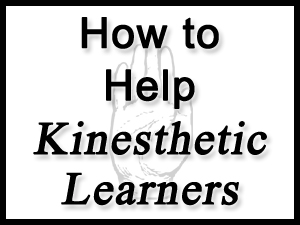Kinesthetic learners like to be in motion. They enjoy experiencing the world through their sense of touch.
As I explained in the first post in this series on Visual Auditory Kinesthetic Learning Styles, it’s a good idea to be knowlegeable of your child’s learning styles. That information helps you to teach more easily and effectively. You can change the curriculum you’re using to work well with your child’s brain.
Kinesthetic learners have their own unique traits and style of learning. I’m going to share with you the characteristics which make them who they are as well as methods you can use when you teach them. It is my hope that this knowledge will help you to succeed in teaching your kinesthetic learner.
*This post contains paid links. I earn a small commission from the sale of products purchased via these links. Please see my disclosure for details.
Characteristics of Kinesthetic Learners
Below is a list of characteristics that a kinesthetic learner can have. Not all of these traits will be true for all kinesthetic learners. If you find that the majority of them are true for one of your children, then the kinesthetic learning style is likely his dominant modality.
Kinesthetic learners:
- like to be active
- prefer hands-on activities
- don’t like to sit still for long periods of time
- have good physical coordination
- talk with their hands
- can be adventurous
- need to take frequent breaks to move around
- like to touch people they speak to
- may struggle with spelling and/or reading
- tap their pencil or foot while studying
- remember what was done better than what was spoken or read
- enjoy actively exploring their environment
- doodle while listening
- like to touch things
- prefer to dress comfortably
- like to talk about or express emotions openly
- enjoy trying new things
- may be impulsive
- learn best by touching, doing and moving
Tips for Helping Kinesthetic Learners
Here are some techniques you can use to help a kinesthetic learner succeed.
- Let your child stand up at a counter to study
- Give your child an exercise ball to sit on instead of a regular chair so that he can bounce
- Provide as many hands-on activities as possible such as projects and experiments
- Let your child take frequent breaks
- Give your child something to do with his hands while listening to a story or studying like playing with Silly Putty or a squeeze ball
- Give him opportunities to physically act out or role play the lesson
- Let him build models
- Go on field trips
- Let him doodle while listening
- Play music for him while he works
- Have him take notes
- When your child has a reading assignment, have him skim through the whole piece first, then go back and read from beginning to end
- Let your child learn by imitating someone
- Give him opportunities to practice a skill
- Let him march, skip, jump, or walk around while learning
- Teach your child rhythmic chants to memorize some material
- Encourage your child to associate feelings with learning some concepts
- Give him cards to sequence
- Let him use brightly colored highlighters
- Encourage him to take deep breaths
- Have your child do things as he says them
- Give him flashcards to study with
- Have him write, then rewrite things that need to be memorized
- Let him use letter tiles or magnetic letters
- Provide manipulatives for him to use
- Encourage him to make mind maps, diagrams, pictures and other visuals to help him learn
- Let him clap out sounds and syllables
- Vary your child’s activities
- Let your child draw letters and numbers in sand or some other tactile environment
- Let him build with LEGOS while listening
Some helpful items to use with a kinesthetic learner include:
- exercise ball
- peanut ball
- squeeze ball
- Silly Putty
- highlighters
- magnetic alphabet letters
- a LEGO® set
- music to listen to
To learn more about the other Visual Auditory Kinesthetic learning styles, click on the links below.








